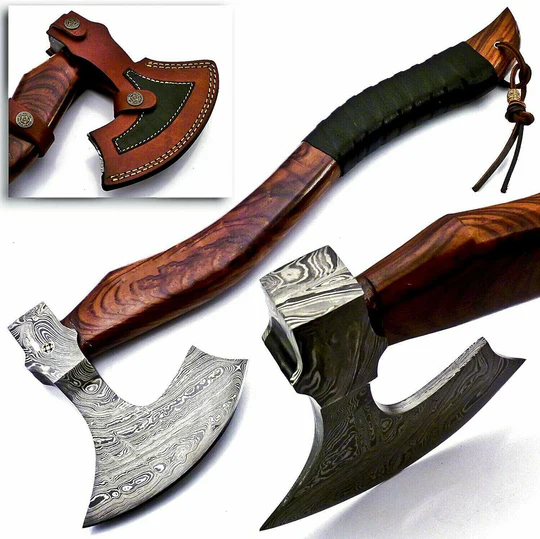Presentation
The Viking Age, spreading over from the late eighth to mid eleventh hundreds of years, is portrayed by its furious heroes, unbelievable investigations, and stunningly created weapons. Among these, the Viking axe remains as a demonstration of the ability and craftsmanship of the Norse public. This article dives into the complexities of the expert carbon steel Viking axe, investigating its authentic importance, properties, and craftsmanship.
Verifiable Meaning of Viking Axes
Viking axes were imperative apparatuses and weapons for Norse heroes, utilized in fights, regular errands, and stately events. The axes plan and usefulness developed after some time, mirroring the requirements and abilities of the Viking society. These axes were not simply devices of war; they were images of force, honor, and social personality.
The Development of Viking axes Craftsmanship
The craftsmanship of Viking axes has advanced essentially from the simple devices of early settlements to the finely sharpened weapons of the Viking Age. Early axes were basic and useful, yet as Viking metalworkers improved their abilities, the plans turned out to be more many-sided and concentrated. The presentation of carbon steel upset hatchet making, taking into account more honed, more strong edges.
Properties of Carbon Steel
Carbon steel is a famous decision for making proficient Viking axes because of its predominant properties:
Strength: Carbon steel is known for its sturdiness and capacity to endure weighty use.
Edge Maintenance: It keeps a sharp edge for longer periods contrasted with different materials.
Hardness: Carbon steel can be solidified to a serious level, upgrading its cutting skill.
Simplicity of Honing: Regardless of its hardness, carbon steel can be somewhat simple to hone, keeping a sharp edge with legitimate support.
The Making System of Carbon Steel Viking Axes
Making a carbon steel Viking axes includes a few fastidious advances:
Producing: The carbon steel is warmed in a fashion until it becomes moldable, then, at that point, pounded on a blacksmith’s iron to shape the cutting edge.
Extinguishing: The hot sharp edge is quickly cooled in water or oil to solidify the metal.
Treating: The solidified sharp edge is warmed to a lower temperature and afterward leisurely cooled to accomplish the ideal equilibrium between hardness and adaptability.
Crushing and Cleaning: The edge is ground to the ideal sharpness and cleaned to a smooth completion.
Handle Development: The handle, regularly produced areas of strength for using like debris or oak, is created and joined to the sharp edge.
Plan Components of an Expert Viking Axes
The plan of an expert Viking axes is both practical and stylish, highlighting:
Unshaven Edge: A snare formed lower edge that gives flexibility in battle and utility.
Wide Bleeding edge: Offers a bigger surface region for striking and cutting.
Many-sided Carvings: Embellishing components like runes and images that add social and emblematic importance.
Kinds of Expert Viking Axes
There are a few kinds of expert Viking axes, each appropriate for various purposes:
Unshaven Axes: Known for its adaptability and adequacy in both battle and ordinary assignments.
Dane Axes A huge, two-gave axe with a long handle, intended for strong swings in fight.
Tossing Axes: More modest and lighter, utilized for went assaults and requiring exact equilibrium.
Expansive Axe: Utilized principally for woodcutting and stately purposes, highlighting a wide edge.
Significance of Equilibrium and Weight in Proficient Axes
The equilibrium and weight of an expert Viking axe are critical to its exhibition. An even axe considers exact control, while the right weight guarantees strong strikes without compromising mobility. The handle length and edge size are likewise key elements in accomplishing the ideal equilibrium.
Runic Engravings and Imagery
Runic engravings on Viking axes were accepted to saturate the weapon with otherworldly properties, summoning assurance, strength, and triumph in fight. These engravings frequently conveyed profound representative implications, mirroring the convictions and upsides of the Viking champion. The consideration of runes adds a layer of social and verifiable importance to the axe.
Applications in Cutting edge Use
Today, proficient carbon steel Viking axes are utilized in different applications:
Verifiable Reenactments: Aficionados and antiquarians utilize these axes in reenactments to rejuvenate Viking history.
Gathering: Authorities look for valid and excellent copies for their verifiable and stylish worth.
Open air Exercises: Current transformations of Viking axes are utilized in setting up camp, woodcutting, and endurance circumstances.
Hand to hand fighting: A few hand to hand fighting disciplines consolidate Viking axe methods in their preparation.
Gathering Credible Viking Axes Gathering credible Viking axes requires cautious thought:
End
The expert carbon steel Viking axes is a noteworthy mix of history, craftsmanship, and social importance. These axes typify the expertise and commitment of Viking metalworkers and act as strong images of the Viking Age. Whether as instruments of war, images of force, or collectible bits of workmanship, Viking axes proceed to rouse and charm, safeguarding the tradition of the Viking Age for people in the future.



